Bits, or Orts, Temari
One of the most favorite ideas shared to TalkTemari through the years has been that of a "Bits" (or orts, or scraps, or trims, or whatever you want to call those small lengths of left-over thread that are not quite long enough to work into a more complex design but long enough that you don't want to just toss them) Temari. The concept came to us from Ozaki Sensei at the JTA via Sue H., from when
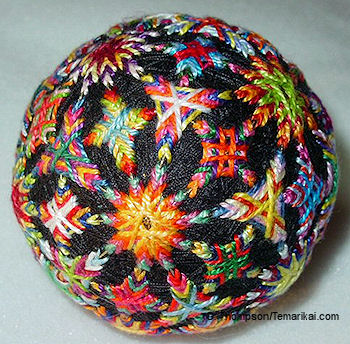 Sue
studied with her. In the old tradition of braided rag rugs,
crocheted granny squares, patchwork quilts - all those time tested ways
to use up the most meager scraps rather than wasting them by discarding,
these Temari tend to always win their share of admiration.
Sue
studied with her. In the old tradition of braided rag rugs,
crocheted granny squares, patchwork quilts - all those time tested ways
to use up the most meager scraps rather than wasting them by discarding,
these Temari tend to always win their share of admiration. Save the trims from your regular work, as long as they can still be threaded into a needle and a stitch or two taken (usually 2-3 inches or longer; shorter than that does make it pretty difficult to still use. But - rather than tossing them, you can save and use as stuffing for mari cores. Better yet, save and put them outside in the spring. The birds love them to weave into their nests, and you'll have the best-decorated yard in town). Prepare a C8 mari, and go from there. You can stitch Kousa-style squares, so that Mitsubishi form, or you can work Kousa-style Sakasa Uwagake on the squares, triangles and diamonds (that's how the photo to the right was done, on a C10). Or, just about anything on any marking. The trick is that each length or each round gets worked in a different thread/color, pulled randomly from your Bits Bag. Don't work more than 2-3 sides of a larger shape, or one round on a smaller one before changing threads in order for this magic to really work.
If you want to up the ante a bit, consider using different fibers as well as random colors in your Bits Temari. You'll need to pay attention a bit to how the different threads merge with each other, but it can really create fabulous temari.
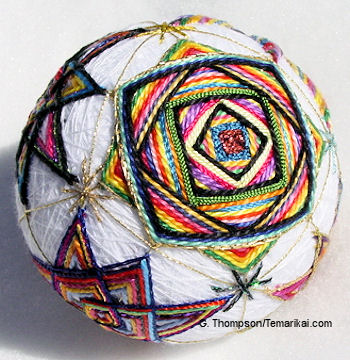 The photo to the right uses may different fibers, including pearl cotton
#5, pearl cotton #8, random metallic threads, and both chained and
unchained bunka.
The photo to the right uses may different fibers, including pearl cotton
#5, pearl cotton #8, random metallic threads, and both chained and
unchained bunka.There are a couple of hints that help: You must pay close attention to starting and ending the threads, being sure that you don't have any tails peeking out, and that you are adequately burying the threads in the mari wrap (see the "Little Things" essay). Also pay close attention to keeping stitching tension even (it can be harder because of the starts and stops), and that your stitching course remains true (same reason). For a truly "sincere" bits ball, keep your orts in a bag and select them randomly, promising yourself that you will stitch with whatever comes out of the bag. You can, of course, cheat a little bit if you prefer, to create more "random" color placements. Stitching a Bits Temari is a bit more labor and time consuming due to all of the starts and stops that need to be done, but the outcomes are worth it.
Here are some additional examples:
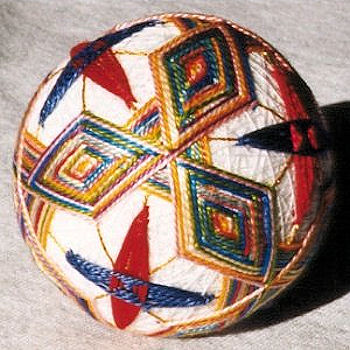 This is Sue's Kousa Squares to form Mitsubishi, on a C8 |
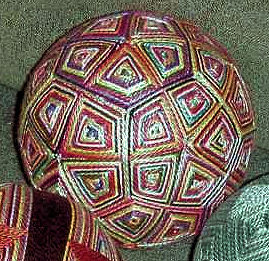 Sarah R. worked this one on a C10, as a Kousa all-over |
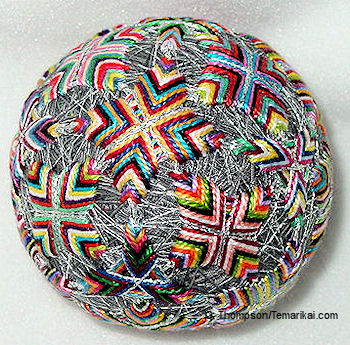 This is the same concept as the black multicolor above, but on C8 |
This
is a TemariKai.com Printable Page; © 2014, all rights reserved.
Right click to print one copy for personal use.
Last updated 1/2014 © 1998 - 2014 TemariKai.com, G. Thompson/PuffinStuff, Inc.
